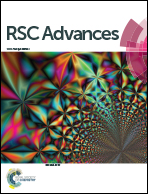A novel synthesis of Fe2O3@activated carbon composite and its exploitation for the elimination of carcinogenic textile dye from an aqueous phase
Abstract
The present work reports the synthesis of Fe2O3@activated carbon composite by the co-precipitation of iron salts onto activated carbon. The prepared composite was explored for the remediation of a carcinogenic textile dye, Remazol Brilliant Blue R (RBBR) from an aqueous solution. The surface morphology, composition and textural characteristics of the prepared magnetic composite (FAC) were investigated by FTIR, SEM-EDS, P-XRD, TEM, selected area electron diffraction (SAED), VSM, TGA, surface area and pore size measurements. TEM images showed that the prepared composites were wire-shaped. The saturation magnetization value (26.99 emu g−1) was sufficient for magnetic separation in wastewater treatment. The unique micro-/meso-porous structure, high surface area (1199 m2 g−1), and pore volume (0.9909 cm3 g−1) further enhance its utilization for the treatment of dye laden wastewater. The pseudo-second-order kinetic model with high correlation coefficients (R2 > 0.999) was suitable to described the process of RBBR adsorption onto FAC. The Langmuir model fitted the adsorption isotherm data better than the Freundlich, Temkin and DR model. Values of thermodynamic parameters (namely, ΔG°, ΔH° and ΔS°) indicated that the adsorption process was strongly dependent on the temperature of the aqueous phase, and it was spontaneous and exothermic in nature. Therefore, FAC composite displays main advantages of excellent dispersion, convenient separation and high adsorption capacity, which implies their potential application in environmental clean-up processes.


 Please wait while we load your content...
Please wait while we load your content...